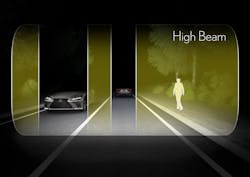ADAS advancements that keep drivers and pedestrians safe
According to the National Highway Traffic Safety Administration (NHTSA), more than 6,000 pedestrians are killed every year in traffic-related accidents in the United States, with many of these fatalities occurring at night. While advanced driver-assistance systems (ADAS) are designed to keep drivers safe, the automotive industry is still working to solve the complex problem of pedestrian safety.
Most vehicles manufactured today are equipped with at least one ADAS feature, but more advanced and emerging technologies are on the horizon and are focused on keeping pedestrians safe. Knowing what advances in vehicle technology are ahead, such as adaptive driving beam headlights, stereoscopic radar and lidar, can help technicians and shops better prepare for the future of collision repair.
Understanding the technology and what types of repairs are required will be key, not only in providing accurate estimates for repairs but in understanding the importance of how to properly repair the vehicle. Technicians need to know how to follow OEM repair procedures to ensure that the vehicle they put back out on the road is safe to operate and that the safety features function as intended.
Headlight technology
Headlight technology hasn’t changed drastically over the last 60 years, with traditional low-beam headlights accounting for most vehicles on the road. The downside of low-beam headlights is they do not allow drivers going at higher speeds enough stopping distance to avoid collisions. Today, LED headlights are becoming more common in newer vehicles in the U.S. While they offer longer light lifespans and better illumination of objects at farther distances, they still fall short in providing adequate visibility for vehicles doing higher speeds, and they don’t offer improved visibility in low light or bad weather.
So, what’s ahead for headlight technology? Currently available in European models but not yet available in the U.S., adaptive driving beam (ADB) headlights automatically adjust the headlights based on ambient light as well as visibility based on the car speed and traffic environment. They function as high beams, helping to improve visibility for the driver; however, they automatically dim when vehicles are directly in front of them, or oncoming traffic is detected by ADAS sensors. ADB headlights allow for better visibility down the road; some of these headlights are mounted on swivel bases that can follow the curves in the road and provide the driver with enough time to react to avoid a collision with another vehicle or pedestrian. As more vehicles become equipped with ADB headlights, vehicles involved in either forward or rear collisions will need to have ADAS features recalibrated during the repair process and will likely cost more to repair and replace.
Pedestrian safety
We all know how difficult it can be to see potential obstacles, whether it’s a car or person on a dark road or in bad weather. While vehicles are equipped with front-facing cameras and offer front collision warnings for objects like other vehicles, approximately 60 percent of new vehicle manufacturers now offer pedestrian or cyclist detection, which uses cameras, radars and sensors to detect pedestrians in the car’s path. If a driver is unable to brake in time, these sensors work in conjunction with the vehicle’s automatic emergency brake to slow down or stop the vehicle.
Current pedestrian warning systems still have limits. The future of pedestrian safety includes vehicles equipped with thermal cameras that can better detect pedestrians in poor visibility conditions because they see pedestrians as heat. This technology is more successful at detecting pedestrians even when drivers are unable to see them. This will be important as the industry moves toward having autonomous vehicles on the road.
Autonomous vehicles
These advances in vehicle technology are bringing the industry closer to having autonomous vehicles on the road. A report from IHS Markit predicts that more than 33 million autonomous vehicles will be sold globally in 2040. These vehicles will need to be able to distinguish other vehicles, pedestrians and cyclists, as well as objects such as stoplights and the like. What technology will be necessary for companies such as Tesla, Google, Waymo and Volvo that already have and/or are testing autonomous vehicles?
A couple of options are at the forefront for the passive sensing needed in AV driving. Vehicle vision systems that are equipped with lidar (light detection and ranging) use cameras and sensors to see objects farther out and can distinguish between static and moving objects. As such, they add another layer of safety to see in low lighting or even work to detect a pedestrian coming out from in-between vehicles. However, costs for those systems are proving to be a challenge.
A less expensive alternative to lidar are stereoscopic radar or stereo vision systems. These systems use two cameras to detect and measure the exact distance to every object in the vehicle’s field of view, regardless of what it is — e.g., another vehicle, a person, a cyclist, road debris, etc.
Whatever the future holds, the evolution of ADAS will likely continue to add system interventions where the safety system reacts if the driver does not or if the driver is behaving in an unsafe manner — e.g., speeding or even driving drunk and weaving between lanes. With AV, it will be more important that these vehicles and their sensors are calibrated correctly to ensure they work as intended to keep everyone safe.
Following OEM repair procedures
Understanding ADAS features on a specific vehicle make and model can be a challenge. OEMs may slightly modify safety features on a vehicle model from one year to the next, which is why technicians must follow OEM repair procedures. Each OEM has unique repair procedures, and following them helps eliminate the guesswork of repairing today’s complex vehicles. With nearly 300 million vehicles on the road, if a vehicle isn’t properly calibrated during a repair, then the driver could be seriously hurt the next time that vehicle is in on the road.
The collision industry can no longer repair vehicles like they used to. With the ADAS features becoming mandatory, it is now more important than ever for repair technicians to understand that technology, know how ADAS sensors work and, more importantly, have the knowledge on how to repair ADAS-equipped vehicles safely and properly to best serve their customers.





